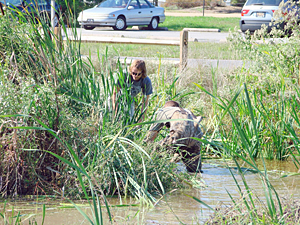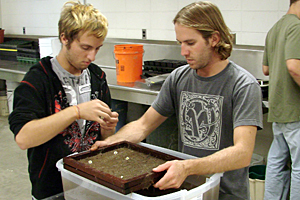ADVERTISEMENT
- Rozovsky wins prestigious NSF Early Career Award
- UD students meet alumni, experience 'closing bell' at NYSE
- Newark Police seek assistance in identifying suspects in robbery
- Rivlin says bipartisan budget action, stronger budget rules key to reversing debt
- Stink bugs shouldn't pose problem until late summer
- Gao to honor Placido Domingo in Washington performance
- Adopt-A-Highway project keeps Lewes road clean
- WVUD's Radiothon fundraiser runs April 1-10
- W.D. Snodgrass Symposium to honor Pulitzer winner
- New guide helps cancer patients manage symptoms
- UD in the News, March 25, 2011
- For the Record, March 25, 2011
- Public opinion expert discusses world views of U.S. in Global Agenda series
- Congressional delegation, dean laud Center for Community Research and Service program
- Center for Political Communication sets symposium on politics, entertainment
- Students work to raise funds, awareness of domestic violence
- Equestrian team wins regional championship in Western riding
- Markell, Harker stress importance of agriculture to Delaware's economy
- Carol A. Ammon MBA Case Competition winners announced
- Prof presents blood-clotting studies at Gordon Research Conference
- Sexual Assault Awareness Month events, programs announced
- Stay connected with Sea Grant, CEOE e-newsletter
- A message to UD regarding the tragedy in Japan
- More News >>
- March 31-May 14: REP stages Neil Simon's 'The Good Doctor'
- April 2: Newark plans annual 'wine and dine'
- April 5: Expert perspective on U.S. health care
- April 5: Comedian Ace Guillen to visit Scrounge
- April 6, May 4: School of Nursing sponsors research lecture series
- April 6-May 4: Confucius Institute presents Chinese Film Series on Wednesdays
- April 6: IPCC's Pachauri to discuss sustainable development in DENIN Dialogue Series
- April 7: 'WVUDstock' radiothon concert announced
- April 8: English Language Institute presents 'Arts in Translation'
- April 9: Green and Healthy Living Expo planned at The Bob
- April 9: Center for Political Communication to host Onion editor
- April 10: Alumni Easter Egg-stravaganza planned
- April 11: CDS session to focus on visual assistive technologies
- April 12: T.J. Stiles to speak at UDLA annual dinner
- April 15, 16: Annual UD push lawnmower tune-up scheduled
- April 15, 16: Master Players series presents iMusic 4, China Magpie
- April 15, 16: Delaware Symphony, UD chorus to perform Mahler work
- April 18: Former NFL Coach Bill Cowher featured in UD Speaks
- April 21-24: Sesame Street Live brings Elmo and friends to The Bob
- April 30: Save the date for Ag Day 2011 at UD
- April 30: Symposium to consider 'Frontiers at the Chemistry-Biology Interface'
- April 30-May 1: Relay for Life set at Delaware Field House
- May 4: Delaware Membrane Protein Symposium announced
- May 5: Northwestern University's Leon Keer to deliver Kerr lecture
- May 7: Women's volleyball team to host second annual Spring Fling
- Through May 3: SPPA announces speakers for 10th annual lecture series
- Through May 4: Global Agenda sees U.S. through others' eyes; World Bank president to speak
- Through May 4: 'Research on Race, Ethnicity, Culture' topic of series
- Through May 9: Black American Studies announces lecture series
- Through May 11: 'Challenges in Jewish Culture' lecture series announced
- Through May 11: Area Studies research featured in speaker series
- Through June 5: 'Andy Warhol: Behind the Camera' on view in Old College Gallery
- Through July 15: 'Bodyscapes' on view at Mechanical Hall Gallery
- More What's Happening >>
- UD calendar >>
- Middle States evaluation team on campus April 5
- Phipps named HR Liaison of the Quarter
- Senior wins iPad for participating in assessment study
- April 19: Procurement Services schedules information sessions
- UD Bookstore announces spring break hours
- HealthyU Wellness Program encourages employees to 'Step into Spring'
- April 8-29: Faculty roundtable series considers student engagement
- GRE is changing; learn more at April 15 info session
- April 30: UD Evening with Blue Rocks set for employees
- Morris Library to be open 24/7 during final exams
- More Campus FYI >>
11:28 a.m., Oct. 25, 2010----The long, slender, grass-like stalks of the cattail plant are often seen as a nuisance in the wetlands located at the College of Agriculture and Natural Resources (CANR). Luckily, members of the Department of Plant and Soil Sciences are transforming the seemingly pesky plants into useful and sustainable everyday products.
This summer, students from the Governor's School for Excellence and UD's Laboratory Preschool teamed up with Chad Nelson, assistant professor of landscape design, to take part in a handmade cattail papermaking process. The goals of this project included using recycled materials to create something new and appreciating the value of developing long-term projects.
The weeklong process enabled students to harvest, dry and cut up cattails from the wetlands. The students were even able to sample the fruits of their labor, as different parts of the cattail plant are edible. The cattail fibers were then pulverized and suspended in water, after which students used a screen and deckle to form paper sheets. The sheets were then pressed to dry.
“It's an interesting process to transform something that is commonly seen as waste into something useful,” Nelson said.
In conjunction with the cattails, Jules Bruck, assistant professor of landscape design, and John Cox, art instructor, are in the midst of the bamboo papermaking process. Bruck and Cox are testing different ways to print on these materials to promote their value as a usable paper alternative.
Both the cattail and bamboo paper will be featured in an exhibit at the Philadelphia Flower Show in February, 2011.
Recently, Nelson also attended a workshop given by Bonnie Gale, professional willow basket maker, at the Mount Cuba Center, a horticultural institution in northern Delaware. Known as the “fence that can grow,” live willow structures provide a unique alternative to regular metal fencing.
The Department of Plant and Soil Sciences is working with the Lab School to use arbors to provide shade on playgrounds, as well as to implement the use of willow structures to educate teachers and children on sustainable landscape design.
Outside of Fisher Greenhouse, CANR students are currently propagating potential green roof plants as test modules for the green roof installation on Colburn Laboratory, the chemical engineering building on central campus.
With the help of Ed Snodgrass, horticultural consultant for green roof projects, CANR hopes to make sound recommendations on “best use” materials for this project.
Many of these plants -- selected based on aesthetics, shallow root systems, resilience, and low-maintenance requirements -- will later be transplanted to the roof of Colburn Laboratory as part of the green roof installation.
Article by Rachael Dubinsky




